



On the afternoon of March 24, General Secretary Xi Jinping visited the historical and cultural block of Sanfangqixiang (Three Lanes and Seven Alleys) during his inspection trip to Fuzhou, capital of Fujian Province, to learn about the local efforts in protecting the block.
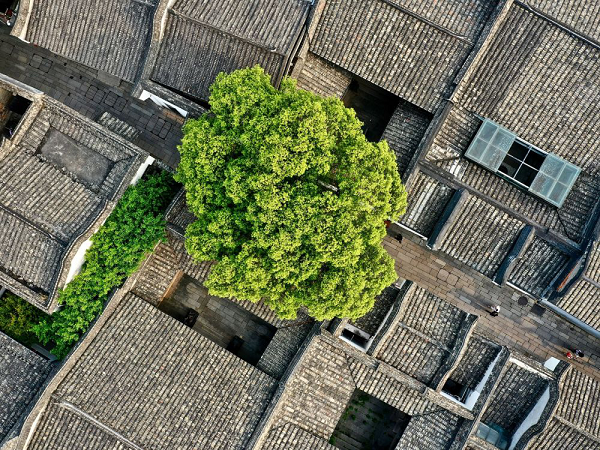
Ancient buildings and trees in the Three Lanes and Seven Alleys (Xinhua/Jiang Kehong)
If you come to Fuzhou, have a visit to the block!
Walking freely in the block, you may be in the most representative lanes and alleys of the Tang and Song dynasties (AD 618-1279) and in the “museum of ancient architecture of the Ming and Qing dynasties (1368-1911)”.

Tourists walked in the Gongxiang Alley on March 14, 2021. (Xinhua/Jiang Kehong)
The Three Lanes and Seven Alleys was first built in the Jin Dynasty (265-420), took shape in the Tang Dynasty (618-907), and flourished in the Ming and Qing dynasties (1368-1911), consisting of Yijin Lane, Wenru Lane, Guanglu Lan, Yangqiao Alley, Langguan Alley, Taxiang Alley, Huangxiang Alley, Anmin Alley, Gongxiang Alley and Jibi Alley. Maybe you neither know its history nor remember the names of these lanes and alleys, you can still more or less feel its historical atmosphere and touch the cultural imprints left by the city’s 2,200 plus years of history.
And the main thoroughfare of the block is Nanhoujie. Every year during the Lantern Festival, it is decorated with a sea of festive lanterns like a street in the sky.
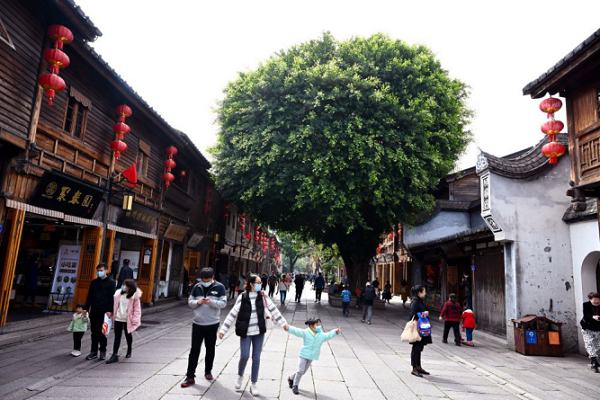
Tourists in Nanhoujie on March 14, 2021 (Xinhua/Jiang Kehong)
In the block, you will be obsessed with Fuzhou’s cork patchwork, Shoushan stone carving, bodiless lacquer and other intangible culture displayed in the Fujian Folk Museum, the Museum of Fujian Intangible Cultural Heritage and the Fuzhou Lacquerware Museum.
If you feel tired during the visit, you can have a rest and taste local snacks, such as fish balls, meat wonton, preserved olive, jasmine tea and Fuzhou rice wine.
However, those are far from enough.
In this block, covering an area of about 40 hectares, you can also see unremitting efforts made by General Secretary Xi Jinping for the continuation of the “root” and “spirit” in Fujian’s culture.
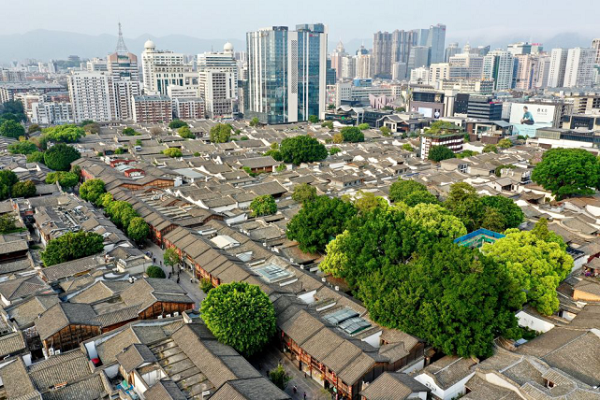
The aerial photo of the Three Lanes and Seven Alleys on March 14, 2021 (Xinhua/Jiang Kehong)
Entering Lin Zexu Memorial Hall, located at No. 16, Aomen Road, you will learn about the inclusive mind and magnanimity of Lin Zexu, a scholar and politician during the Qing Dynasty (1644-1911) and the first person with a global mindset in modern China.
As the Secretary of the CPC Fuzhou Municipal Committee, Xi put great emphasis on the protection and renovation of Lin Zexu’s relevant cultural relics and called for inheriting and developing Lin Zexu’s spirit and demeanor.
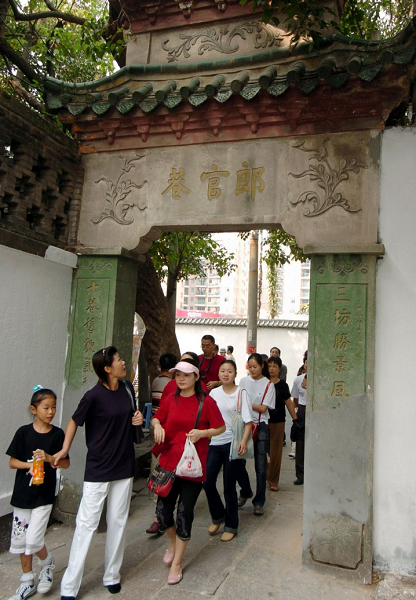
Tourists visited the Langguan Alley on October 1, 2004. On that day, tour routes to former residences of celebrities in the Three Lanes and Seven Alleys were opened, and it was the first time for the newly renovated ancient buildings in the block to be formally open to tourists. (Xinhua/Jiang Kehong)
In the Langguan Alley, you will see the former residence of Yan Fu, a well-known translator, which covers an area of over 600 square meter. In his residence, you will know of the story behind his translation of Evolution and Ethics.
As the Deputy Secretary of the CPC Fujian Provincial Committee, Xi spoke highly of Yan Fu at the Seminar on Yan Fu and Chinese Modernization in 1997.
At the east end of Yangqiao Road lies the former residence of Lin Juemin, a martyr of the 1911 Revolution, and Bing Xin, a literary master. In the place, you will be touched by Lin Juemin’s A Letter to My Wife and be gratified by Bing Xin’s life in Fuzhou.
These lanes and alleys carry the history, record memories and inherit the spirit. Fujian people never forget what General Secretary Xi Jinping has said.
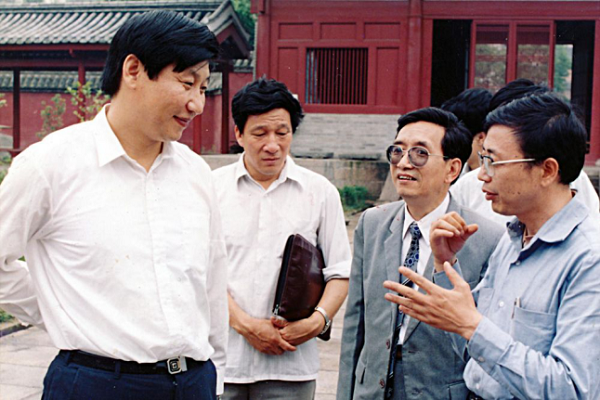
Xi did the research in the Hualin Temple in Fuzhou on June 8, 1990.
Since the 1990s, the CPC municipal committees and governments of Fuzhou have vigorously promoted the protection of cultural relics and ancient buildings. To this day, stories about setting up the Cultural Heritage Administration, forming an archeological team, issuing a stamp to approve the construction within the protected area, and earmarking 1 million yuan every year as funds for protecting the cultural relics are still on people’s lips in the cultural circle. And it was Xi Jinping, then Secretary of the CPC Fuzhou Municipal Committee, who made the decision to carry out the above-mentioned work.
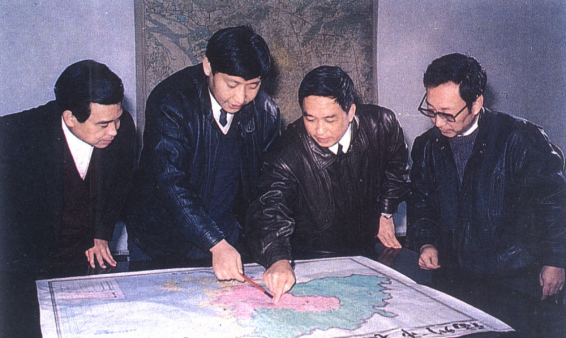
Xi was discussing with his colleagues about the strategic plan of Fuzhou in December, 1991.
In April, 2002, while serving as Governor of Fujian, Xi wrote in the preface to the book Fuzhou Ancient Buildings, written by Zeng Yidan, former head of the Fuzhou Cultural Heritage Administration: “Protecting ancient buildings and cultural relics is preserving history, culture and an intangible fine tradition of the renowned historical and cultural city.”
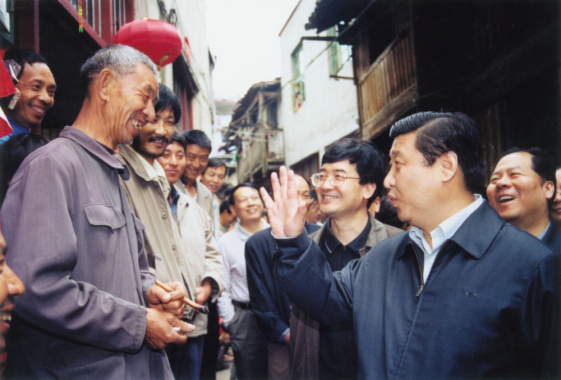
On April 8, 2002, Xi was in Heping Town, Shaowu City, Nanping for inspection.
On the first day of his inspection trip to Fujian this time, General Secretary Xi Jinping mentioned cultural confidence: “Without 5000 years of Chinese civilization, we wouldn’t find the way to success.”
Culture is the soul of a country and a nation. Let us put our firm confidence in culture into practice and make joint efforts to realize the Chinese Dream of national rejuvenation.
(Source: Xinhua News)